Green Bay, Wisconsin
I’ve shied away from mentioning politics in my reviews except for the occasional broad pop-culture reference, in part this because I don’t want to potentially alienate any readers, but also because I try to avoid politics within my own life as much as possible. Whether on the left or right, many people have a perverse tendency to make their political identity the deepest core aspect of their personal identity. To claim to be a “liberal” or “conservative” is to orient one’s individual placement in the world within the context of a particular mass narrative. It’s a means to limit personal responsibility against our own ethical self-determination; our concerns and conclusions both tidily handed to us from mass society, fueled particularly by the media outrage machine.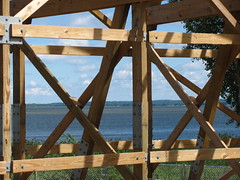
I guess in a highly atomized society people need to feel part of whatever collective they can find association with, and part of what it means to be in a collective is to have an easily defined “other” to fulfill certain roles in the mass narrative. We see this in-grouping on all sorts of hierarchies, whether at the level of the nation-state, the political party, and even within sports teams. (By the way, if you’re a self-professed liberal/conservative and you’re thinking as you read this, “hell yeah, the other side is always like that”, then do me a favor and slap yourself in the face really hard right now.)
As soon as I identify myself as being oriented within a certain group, I risk becoming the “other” and having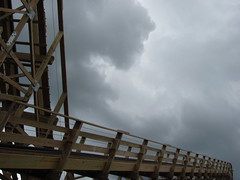 the interpretation of my words twisted even more than ordinarily due to my strange syntax and undertones of stoner college student pretentiousness. Which is why I try to talk philosophy rather than politics whenever I’m not being a complete roller coaster dork.
the interpretation of my words twisted even more than ordinarily due to my strange syntax and undertones of stoner college student pretentiousness. Which is why I try to talk philosophy rather than politics whenever I’m not being a complete roller coaster dork.
Be that as it may, with all the current debate on the American budget deficit and governmental spending (and with apologies to my many international readers), I’ve felt compelled to share my own opinion on the matter.
In a gross simplification of the current cable news discourse, it seems you’re either for big government or big business, and both are radically different and diametrically opposed institutions.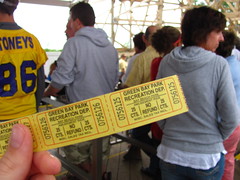 I, however, fail to notice any significant difference in their respective functions. Both are autonomous, self-created organizations of human beings that maintain certain power relationships with the rest of society as a means of organizing resources and labor. Government is much more monopolistic in nature than business, but it hopefully makes up for that by being more democratic and responsive to non-profit motivated needs. Otherwise to me they seem to both be variations on the same basic idea, and until we achieve some sort of neo-Marxian, post-capitalist-and-nation-state political economy where resource allocation and information dissemination is completely decentralized through the next generation of world wide web, I don’t see the need to pretend like one is morally superior than the other.
I, however, fail to notice any significant difference in their respective functions. Both are autonomous, self-created organizations of human beings that maintain certain power relationships with the rest of society as a means of organizing resources and labor. Government is much more monopolistic in nature than business, but it hopefully makes up for that by being more democratic and responsive to non-profit motivated needs. Otherwise to me they seem to both be variations on the same basic idea, and until we achieve some sort of neo-Marxian, post-capitalist-and-nation-state political economy where resource allocation and information dissemination is completely decentralized through the next generation of world wide web, I don’t see the need to pretend like one is morally superior than the other.
And frankly, I don’t care which side you pick as long as it gets the job done effectively.
The current popular discourse that claims that only one method can be systemically better than the other in my opinion is a far bigger problem than GM laying off another round of employees or the federal government wasting a couple grand of taxpayer dollars on some imbecilic party. There are mounds of economic research that support free markets as the best ways of managing capital, just as there is for scholarship that supports a view that shared expense public resources can be more economically efficient than profit driven competition. Both are probably true within certain circumstances, and neither is particularly interesting enough to warrant shouting at other humans in town halls or online just because they happened to have picked the other team. And even if it was, the complexity of this economic relationship cannot possibly be reduced to fit on a political bumper sticker.
Because, really, our problem is not that we suffer from a budget deficit. Want to know how to make a budget deficit go away? Well, if you print the money, the answer is simple. It’s called an eraser.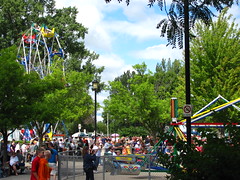
No, our problem is that we have a value deficit.
Which brings me figuratively and literally to Green Bay, Wisconsin.1 Roller coasters and amusement parks are generally within the domain of private enterprise, but not in Green Bay. With a history dating back to the 1890’s, over the years Bay Beach has hosted various entertainments from swimming, dancing, roller skating, and even a couple of roller coasters. Today it is a free-admission park under the public ownership of the City of Green Bay. Rides are few in number, covering only most of the basics such as a Ferris Wheel, Scrambler, Tilt-a-Whirl, Bumper Cars, Chair Swings, Minature Train, and a spinning torture device known only as a SCAT.2 Tickets are a mere 25 cents each, with attractions requiring anywhere from one to four tickets to ride. As we pulled up to the park on Labor Day weekend Sunday, we found the place was jam-packed and could not find a parking spot anywhere. When we finally did get in we discovered an approximately twenty minute wait for the starring new attraction, despite running two thirty-passenger trains with reasonable dispatch efficiency. Although slightly frustrating for us long-distance travelers on a tight schedule, it was amazing to witness how such a small, simple park could have so much value for so many people.
SCAT.2 Tickets are a mere 25 cents each, with attractions requiring anywhere from one to four tickets to ride. As we pulled up to the park on Labor Day weekend Sunday, we found the place was jam-packed and could not find a parking spot anywhere. When we finally did get in we discovered an approximately twenty minute wait for the starring new attraction, despite running two thirty-passenger trains with reasonable dispatch efficiency. Although slightly frustrating for us long-distance travelers on a tight schedule, it was amazing to witness how such a small, simple park could have so much value for so many people.
The main reason we, along with so many others, were here this weekend was for the new roller coaster the city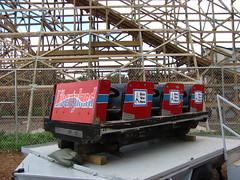 had commissioned for that year. The Zippin Pippin is a relocation (or to be more precise, a re-creation) of the John Miller designed coaster formerly located at Libertyland Amusement Park in Memphis, Tennessee. Supposedly it was Elvis Presley’s favorite roller coaster, a small bit of notoriety that made the Zippin Pippin a more marketable relocation project to be chosen over a couple of other worthy relocation candidates in Ohio that would have been in better condition and with unique salvageable rolling stock. Arguably paying $35,000 at auction for what ultimately amounted to the rights to the blueprints (would need to be radically redesigned anyway), name (a generic title for coasters of that era that I’m skeptical would receive copyright protection from the defunct Libertyland) and a few worthless pieces of equipment (a couple signs
had commissioned for that year. The Zippin Pippin is a relocation (or to be more precise, a re-creation) of the John Miller designed coaster formerly located at Libertyland Amusement Park in Memphis, Tennessee. Supposedly it was Elvis Presley’s favorite roller coaster, a small bit of notoriety that made the Zippin Pippin a more marketable relocation project to be chosen over a couple of other worthy relocation candidates in Ohio that would have been in better condition and with unique salvageable rolling stock. Arguably paying $35,000 at auction for what ultimately amounted to the rights to the blueprints (would need to be radically redesigned anyway), name (a generic title for coasters of that era that I’m skeptical would receive copyright protection from the defunct Libertyland) and a few worthless pieces of equipment (a couple signs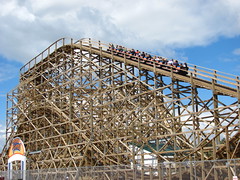 and the lead car of a poorly conditioned PTC train that dates no earlier than the late 1960’s), was something of a bone-headed move, but I don’t think public or private ownership was in any way a unique cause.
and the lead car of a poorly conditioned PTC train that dates no earlier than the late 1960’s), was something of a bone-headed move, but I don’t think public or private ownership was in any way a unique cause.
To be honest, the new Zippin Pippin looks very little like the old one. Not a single mechanical part from the original ride made its way to Green Bay save for a few pieces of ornamentation near the entrance. The Gravity Group, working with Martin & Vleminckx (say that name five times fast) took the basic configuration of the Memphis coaster and completely updated it to 2011 standards. Except for the brakes, lift, and coaster cars (salvaged from the much more recently constructed Thunder Eagle coaster, also formerly from Tennessee) all the materials are brand new.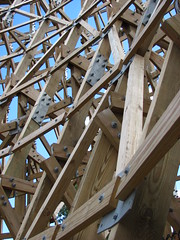 Even the basic look and feel of the old wooden coaster has changed considerably. The trains have been extended to a chain five cars with individual ratcheting restrains, which I assume gives it a different pace over the hills than the shorter configuration of the original ride. The wooden structure has a modified construction using bolts and square steel plates instead of simply nails, the shimmering silver in the structure almost immediately giving the ride away as a totally modern coaster with only the vaguest real connection to the past. I know nails in wood are a bit more archaic (although it’s still no problem for Great Coasters, Intl.) but given that this was supposed to be branded as a relocation of a historic ride would it have been too much to ask for some construction techniques that were still popular less than five
Even the basic look and feel of the old wooden coaster has changed considerably. The trains have been extended to a chain five cars with individual ratcheting restrains, which I assume gives it a different pace over the hills than the shorter configuration of the original ride. The wooden structure has a modified construction using bolts and square steel plates instead of simply nails, the shimmering silver in the structure almost immediately giving the ride away as a totally modern coaster with only the vaguest real connection to the past. I know nails in wood are a bit more archaic (although it’s still no problem for Great Coasters, Intl.) but given that this was supposed to be branded as a relocation of a historic ride would it have been too much to ask for some construction techniques that were still popular less than five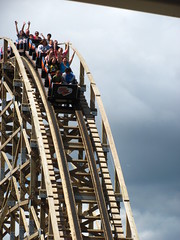 years ago? I was almost made to wonder if it wouldn’t have been cheaper and easier to have simply designed a brand new coaster from scratch. Surely the Elvis appeal can’t sell that many tickets in this day and age, especially in northern Wisconsin?
years ago? I was almost made to wonder if it wouldn’t have been cheaper and easier to have simply designed a brand new coaster from scratch. Surely the Elvis appeal can’t sell that many tickets in this day and age, especially in northern Wisconsin?
Yet such criticisms would overlook the fact that the new Zippin Pippin is, in fact, an excellent ride that maybe even manages to better some of the other modern designs produced by the Gravity Group. I’ve noted in the past that contemporary roller coaster design tends to put too much emphasis on serpentine configurations that you often can’t sort it all out in your mind as you’re riding it and the experience only morphs into an onslaught of random sensations that all stay comfortably within the same force and dynamics limitations set by the computer. It seems that a return to the classics has allowed the Gravity Group to get a bit more character out of a ride that otherwise would have a lot less to offer than their much larger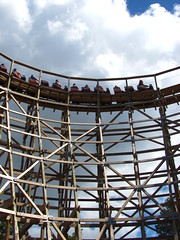 and more ambitious debut project located a couple hours south.
and more ambitious debut project located a couple hours south.
It alternates between slow panoramic views of Green Bay with a couple of big, fast drops in the beginning. One odd feature I noticed was that the turns weren’t built in a perfect circle, but instead had this strange shuffling effect built into the track. From the front row you can see quite clearly with the naked eye that the rails follow an octagonal pathway more than a circular one. I’m not sure if this was deliberate on behalf of the Gravity Group, or if it was found in the original Zippin Pippin layout (there’s some evidence there was in this video, but not nearly to the degree I recall from the new design), but it’s at least one way this coaster distinguishes itself from the crowd.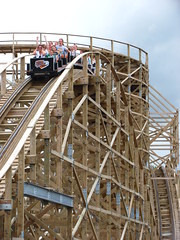
It then transitions to a more tightly paced series of airtime hills that run away from the park alongside the bay. These hills have a nice rhythm to them, achieved through an uneven variation of triangular profiles that provides an interesting sequence of anticipation-pop-resolution-valley-repeat; for me much more colorful than identical parabolic crests and valleys plugged directly into each other. The second-to-last hill is especially worth mentioning. This seemingly innocuous hill has an extremely angular crest that will (excuse my French) kick the shit out of you. Negative G-forces to the extreme, although sustained only for a split second, ride in the Herb Schmeck seat (third row, first car) only if you dare. The short duration and presence of individual ratcheting lapbars means Cyclops is still the go-to ride in the state of Wisconsin if you like ejector airtime, but this tiny hill certainly gives The Drop a run for its money, especially because it happens with almost no warning or time to prepare. Like the octagonal curves, I can’t figure out if this was an intentional or even historical design feature, but regardless I like it.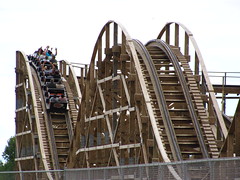
Due to the long lines and the fact that we needed to get down to Marshall before Little Amerricka would close I only had enough time for three rides on the Zippin Pippin; first in the front row, then in the back, and finally in row 1-3. The third ride was the best, although folks with milder dispositions might prefer a seat somewhere in the middle of the train away from a wheel seat. Not an ideal lap count given the travel distance involved, but I was hardly in any mood to complain because it delighted me to no end to see that an honestly pleasant small park could be so popular just for adding a no-frills wooden coaster, especially compared to the relatively big-budget commercial tackiness found in the Dells the day prior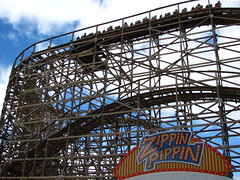 which could barely manage to find enough customers to fill all the seats on much larger coasters operating at one-third the capacity.
which could barely manage to find enough customers to fill all the seats on much larger coasters operating at one-third the capacity.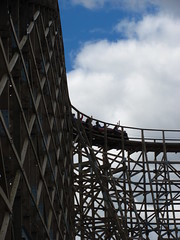
That’s how you fix a value deficit. If your situation happens to be that you’re on a city planning council and you can figure out a way to create something of value for the city, don’t sit around twiddling your thumbs waiting for the invisible hand of the marketplace to come to the rescue instead, based on some faith that small government must always necessarily be for the best. Take initiative and make it happen using whatever resources you have available and under whatever political-economic system there happens to be. That’s what the City of Green Bay did, and now they have a great wooden roller coaster where once there was none, and it’s an investment that’s depositing considerable returns back into the pockets of local taxpayers. If a private business could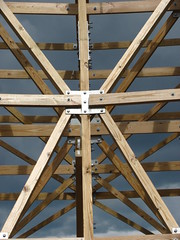 have managed the same, then that’s also great and I hope few people stand in the way of that drive unless there was a legitimate reason to do so.
have managed the same, then that’s also great and I hope few people stand in the way of that drive unless there was a legitimate reason to do so.
But it’s not even about the coaster’s profitability. As I said, it’s about the value that this endeavor has created for the people of Wisconsin and beyond. “Value” can sometimes seem like an abstract entity when decoupled from monetary currency that makes it easy to track and quantify, even though in reality “value” is far more concrete than “money”. So I’ll give you an example of what I mean by “value”. The physical nuts and bolts that construct the meaningful world we inhabit, that’s value. Thirty seats on a roller coaster that will each encounter nearly ten moments of weightlessness or negative G-forces on a single lap, that’s value. Children screaming and laughing with their parents when it’s all over, that’s value. Standing in line on the stairway to the loading station next to an extended family group, the middle-aged son turning to thank his aging father for bringing all his siblings together for one last occasion before the summer was over, that’s real value.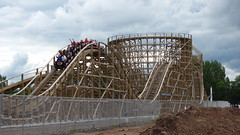
The Zippin Pippin is valuable for this country, and I thank the men and women that made its relocation/re-creation in Green Bay possible. I hope more cities, businesses, and individuals around the world will have the courage to follow their lead.
Footnotes & Annotations
[1] Wow, that had to have been the worst introduction to a roller coaster review, ever.
[2] Although I failed to get a photo of the ride, if you want an idea of what this flat ride looks like, DO NOT UNDER ANY CIRCUMSTANCES do a Google image search for “scat”, especially if the safe search is turned off. I now deeply apologize for putting that idea in your head.
Nice review. I’m too tired to hit on all your points but I’ll say that the choppiness in the turns likely wasn’t designed in, M&V just sucks at turns. I believe the support structure is circular, but when it gets to the point that you describe as ‘octagonal’ is where the turn starts to bank (about halfway through it’s vertical change, thus picking up speed) and it was likely just an error in tracking that transition into the bank. Pretty much every ride M&V has built has had this problem….Hades (which they did the tracking on) had the same problem in it’s station flyby turn which I believe was recently fixed in one of it’s retrackings, Boardwalk Bullet used to have it pretty bad in it’s bay turn, Yankee Cannonball has it in it’s turnaround that M&V rebuilt in 2003, etc (Voyage had some issues in it’s turn before the S-hill/station flythrough but I’m not entirely sure M&V tracked that one). They seem to be awesome at hills and valleys as those are usually pretty smooth, but for whatever reason they can’t get the turn thing down.
wow! some people are just cry babies like spoiled litle brats “long travel, tight schedule BOO HOO HOO!!!! hope you don’t have children that end up just like you unsatified with anything and everything sounds like lol:) I think its awesome great park, happy kids, not a perfect place but really your going to complain over a 25 cent ride??? come on, get a grip on the zip, DICK.
I knew I had gone far too long getting nothing but intelligent and respectful comments from people, so thank you Tracy Jane for reminding me that the stereotypically clueless internet user still exists after all.
Great review of a roller coaster that has great value. At $1 a ride the Zippin Pippin has to be one of the best bang for the buck coasters that I’m aware of. Bay Beach may not have the latest and greatest with their other rides, but my family of 4 can have a great time there for under $25 a day including snacks. My family loves going to Six Flags Great America as well, but I always feel like I’m being held up at gunpoint there.
By the way, I’ve only rode the Scat once, and that was enough for me.